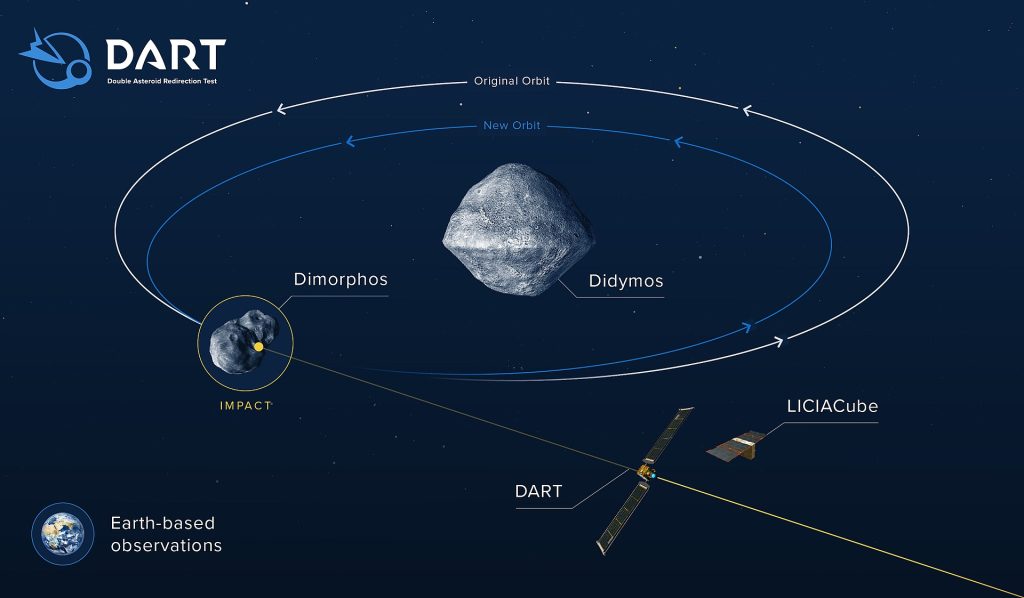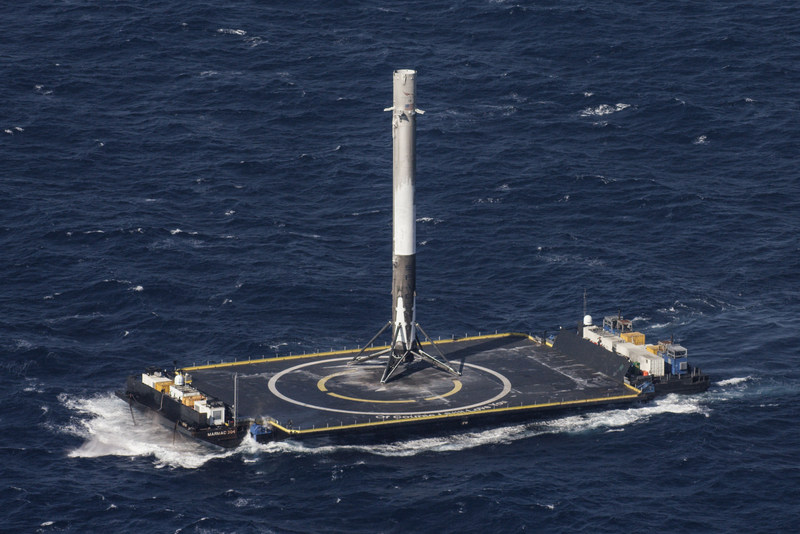Two years ago I published a detailed blog post: Will an asteroid hit Earth? In that post I discussed the scenario that an asteroid had been discovered on a collision course with Earth and what could be done to avoid such a possibly catastrophic collision. One option is to send a spacecraft to the asteroid and let it crash with it. The impact should change the course of the asteroid, so it would no longer hit Earth.. The DART mission will test the feasibility of this “kinetic impactor” technique. DART will be launched on 24 November, so it is time for an update.
The acronym DART stands for Double Asteroid Redirection Test. Target for DART is the minor asteroid Didymos, discovered in 1996. It has a diameter of 780 meter and orbits the sun in 2.11 year. In 2003 it was discovered that Didymos has a small moon with a diameter of 160 meter. This moon has been named Dimorphos , it orbits Didymos in about 12 hour at a distance of 1.2 km. DART will crash into this moon at a speed of 6.6 km/s. and change its orbit slightly. In the infographic this change is hugely exaggerated. It is estimated that the crash will change the speed of Dimorphos only about 0,4 mm/s and its orbital period about 10 minutes
Originally DART was part of the much more ambitious AIDA mission. The crash will take place at about 11 million km from Earth. How to observe the effects of the crash? The solution was to launch another spacecraft earlier than DART, which would reach Didymus and go into orbit around the asteroid. This AIM spacecraft , to be developed by the European Space Agency (ESA), would observe the crash and send data back to Earth. It would even deploy a small lander, MASCOT2 to study the properties of Dimorphos.
But in December 2016, AIM was cancelled by ESA, after Germany withdrew the 60 million Euro funding for the project. I commented in the above mentioned blog:
As an European I feel rather ashamed that Europe has acted this way.
NASA decided to continue with DART., which will be launched by a SpaceX Falcon 9 rocket. A fascinating feature from the Falcon 9 is that part of it (the first stage) will return to Earth, land vertically (!) and can be used again for other missions. It will land on a so-called drone ship, an unmanned platform in the ocean. There are three of these drone ships active at the moment, all with poetic names. The Falcon 9 will land on “Of Course I Still Love You” Here is the ship.
And here is a video of the take off and landing. You must see it to believe it ;-).
DART will arrive at the asteroid end of September 2022. The spacecraft will use autonomous navigation to point itself to the moon. It has a camera on board, the DRACO that takes high-resolution photos. On-board software will analyse these photos, be able to distinguish between Dimorphos and Didymos and point Dart to Dimorphos.
About 10 days before reaching its destination, DART will deploy a tiny spacecraft, a so-called CubeSat . This LICIACube has been developed by ASI, the Italian Space Agency and will take pictures of the crash. So at least images of the collision will be sent to Earth.
Here is a short YouTube video of the DART mission. I will point out a few details.
- 0:07 The nose cone of the Falcon 9 opens to deploy DART
- 0:15 the solar arrays are unrolled, a new technique. Each one is 8,5 m ;long
- 0:22 The lens cover of DRACO opens
- 0:26 Didymos in the center, Dimorphos to the right
- 0:32 The orbits of Earth and Didymos. They comes close, but are still 11 million km away from each other when DART crashes.
- 0:37 The Xenon thruster will steer the spacecraft
- 0:41 The LICIACube is deployed
- 0:54 DRACO will find the target
- 0:58 Found the target
- 1:02 On collision course
- 1:04 The end of DART
My next update about DART will probably be in October next year.



Thanks jan
This is so interesting.
Thanks for this jan
Wow. !